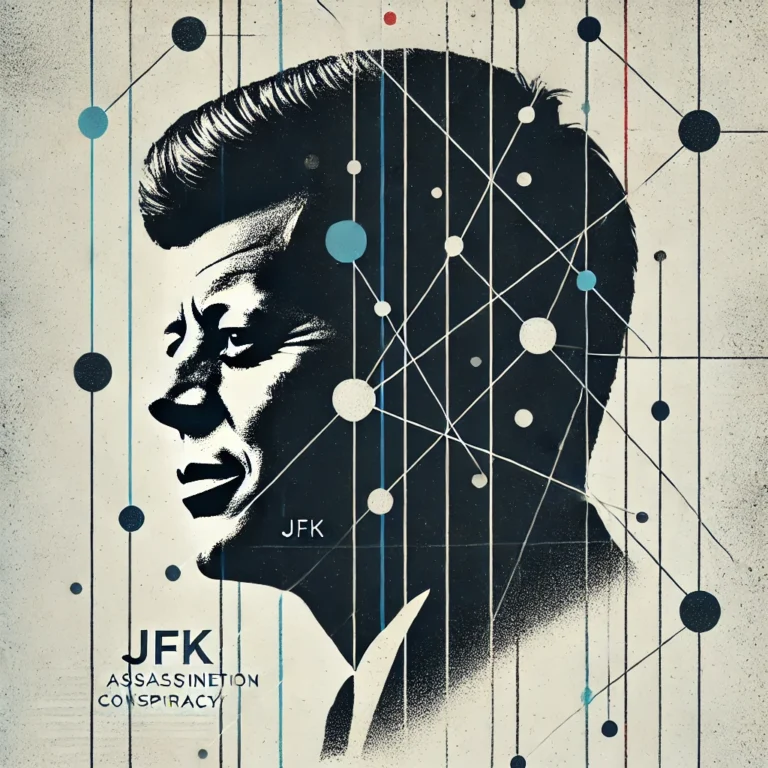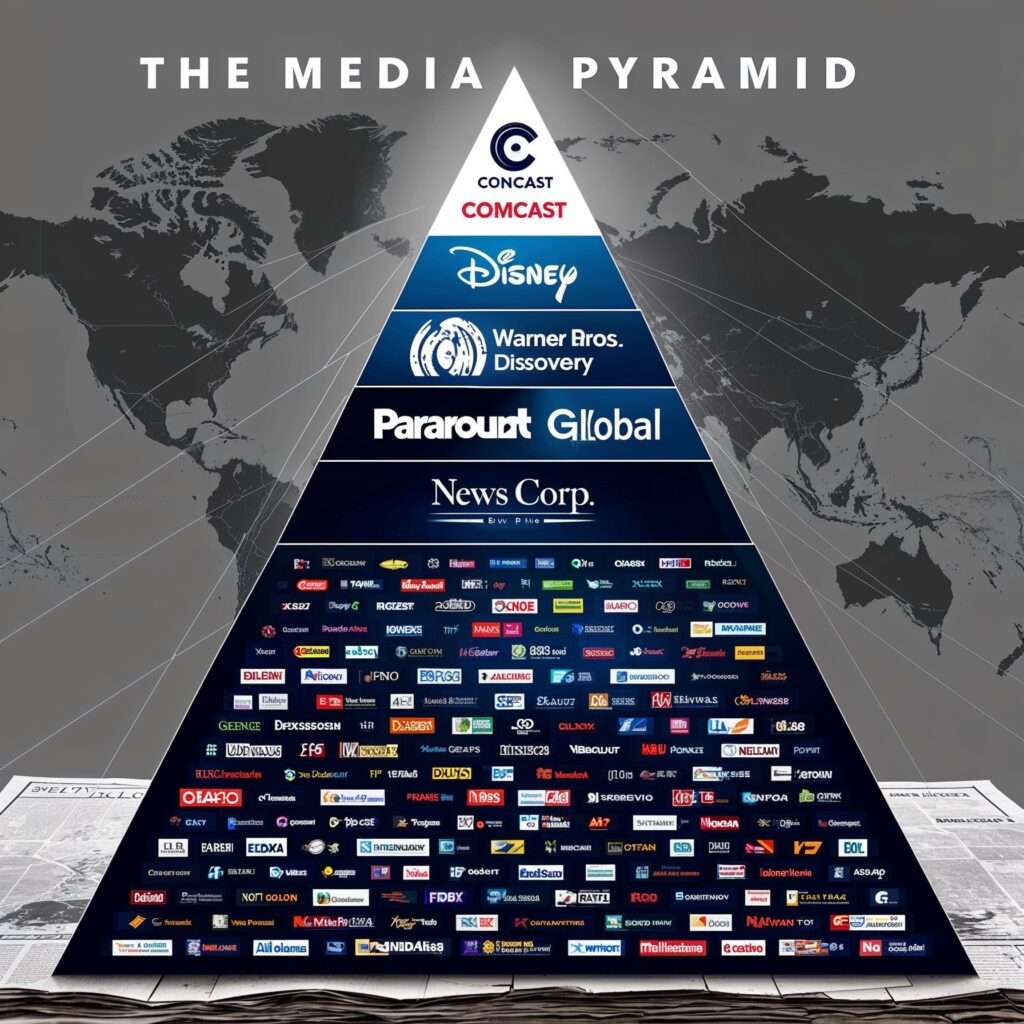
"The hierarchical structure of media ownership, revealing how a handful of corporations control vast amounts of information."
In today’s hyperconnected world, mainstream media influence claims to be the arbiter of truth—a beacon guiding society through the chaos of information. Yet beneath its polished exterior lies a far more insidious role. Far from being impartial conveyors of facts, mainstream media often serves as a subtle yet powerful tool for shaping public opinion and crafting collective beliefs. As media ownership consolidates and narratives are meticulously tailored, one pressing question arises: does the media seek to inform—or to manipulate?
The Evolution of Mainstream Media Influence: From Noble Ideals to Corporate Machinery
When pioneering news agencies like Reuters, the Associated Press (AP), and Agence France-Presse (AFP) were established, they stood as guardians of democracy, championing the dissemination of unbiased information. Their mission was clear: empower the public with facts to safeguard freedom and equality.
However, the rise of mass media brought with it a tectonic shift. Journalism, once a bastion of public service, transformed into a profit-driven industry. Influence became as valuable as information, and the ideals of objective reporting were gradually eclipsed by the pursuit of revenue.
The Era of Corporate Dominance
Ownership of media outlets, once spread among diverse voices and independent organizations, is now concentrated in the hands of a few multinational corporations. These entities often maintain deep ties to political and financial elites, subtly aligning media narratives with their vested interests. The outcome is a blurring of the line between journalism and propaganda, leaving audiences to navigate a carefully curated version of reality.
Key Example: The Consolidation of Media Ownership
By 2024, the global media landscape is dominated by just five corporate giants: Comcast, Disney, Warner Bros. Discovery, Paramount Global, and News Corp. These companies wield vast influence across traditional news outlets, entertainment platforms, and digital media. Their consolidated power creates a harmonious ecosystem where dissenting voices are marginalized, and narratives are streamlined to serve broader corporate or political agendas.

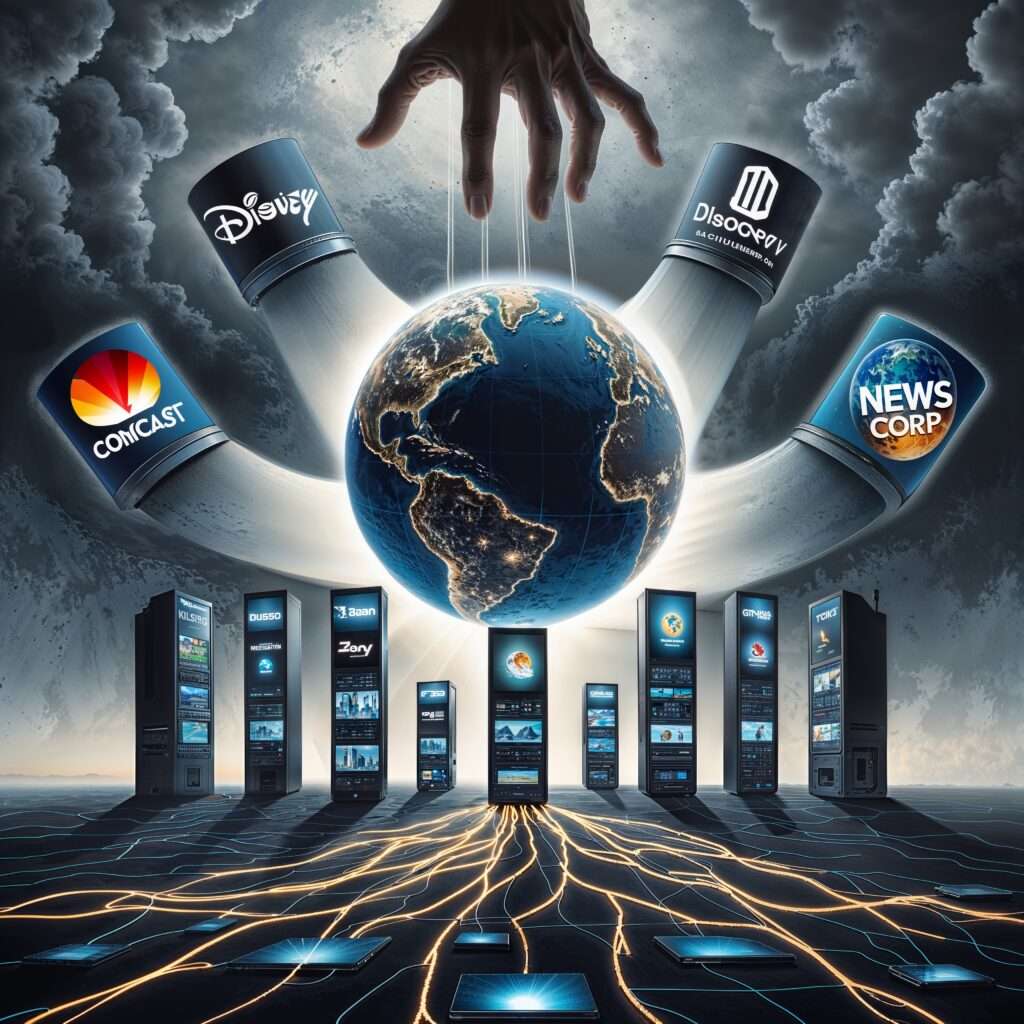
The Concentration of Mainstream Media Influence: How the Few Control the Many
Modern media functions less like a free marketplace of ideas and more like a tightly controlled empire. Centralized agencies such as Reuters, AP, and AFP serve as the primary gatekeepers of news, distributing content that becomes the foundation for countless outlets worldwide. This creates the illusion of diversity in reporting, masking the reality that much of what we consume originates from the same sources.
The Illusion of Choice
Local and international media outlets often republish stories from these centralized agencies with minimal alteration. This process homogenizes the narrative, stifling diversity of thought. While it may appear that audiences have access to a wide range of perspectives, they are, in reality, hearing a single, carefully orchestrated tune dictated by those in power.
Example: Coordinated Global Narratives
Take geopolitical conflicts as a case study. In these scenarios, Western media often delivers a unified narrative, painting one side as the hero and the other as the villain. This consistency is no accident; it’s the result of centralized agencies shaping the framework of global opinion. Such alignment ensures that dissenting perspectives are suppressed, leaving little room for alternative viewpoints to reach the mainstream.
How Mainstream Media Shapes Public Opinion: Techniques of Influence
Mainstream media wields a range of sophisticated techniques to guide public perception, ensuring that their carefully crafted narratives are accepted as reality. These strategies often blur the line between truth and manipulation, subtly embedding their influence into collective consciousness.
1. Selective Storytelling: Controlling the Narrative
The choice of which stories to highlight and which to ignore is one of the most effective tools of influence. By focusing public attention on certain events while omitting others, media outlets shape the audience’s understanding of the world.
How It Works
- Highlighted Stories: Events or topics that align with powerful interests receive extensive coverage, often dominating headlines and broadcasts.
- Ignored Stories: Issues that challenge dominant power structures or offer alternative perspectives are downplayed or completely excluded.
This selective emphasis not only dictates what the public talks about but also skews their perception of what matters most.

2. Language and Imagery: Framing the Narrative
The words and visuals used by mainstream media are anything but neutral. Language and imagery are carefully curated to evoke specific emotions, shape opinions, and frame stories in alignment with desired perspectives.
Examples of Framing
- Language: Terms like “freedom fighter” versus “terrorist” influence the audience’s moral judgment of individuals or groups.
- Imagery: Photos and videos are chosen to evoke sympathy or disdain. For instance, a heartwarming image of one group and an unflattering photo of another can tilt public sentiment without a single word being spoken.
By shaping how stories are framed, media outlets can manipulate public perception before facts are fully processed.
3. The Role of “Experts”: Legitimizing Narratives
Mainstream media frequently elevates experts to provide analysis and commentary. While these individuals are presented as neutral authorities, their affiliations often reveal a deeper agenda.
The Expert Illusion
- Many of these experts have ties to think tanks, corporations, or governments that benefit from the narrative being promoted.
- Alternative experts, who may offer dissenting views, are rarely given the same platform or visibility.
By curating a roster of aligned voices, mainstream media adds a veneer of legitimacy to their chosen narrative while sidelining competing viewpoints.
4. Repetition and Consensus: The Echo Chamber Effect
Repetition is a cornerstone of influence. When the same story is echoed across multiple outlets, it creates the illusion of consensus, making the narrative appear more credible.
The Power of Repetition
- Repeating a story across platforms reinforces its perceived importance and validity.
- Dissenting opinions are labeled as fringe or irrational, discouraging critical thought and open debate.
This “echo chamber” effect creates a feedback loop where audiences are exposed to the same perspectives repeatedly, normalizing the narrative as fact.

The Subtle Art of Influence Conclusion
Mainstream media’s influence lies not in overt coercion but in its ability to subtly guide perception through storytelling, framing, expert selection, and repetition. Recognizing these techniques is the first step toward fostering critical thinking and resisting manipulation. In a world saturated with information, understanding the mechanics of influence is essential for navigating truth from fiction.
The Digital Age: How Algorithms Amplify Mainstream Media Influence
The advent of social media has revolutionized how information is consumed, adding a new layer of complexity to the already far-reaching influence of mainstream media. Algorithms designed to prioritize engagement have become powerful amplifiers, favoring sensationalist or emotionally charged content. This dynamic gives mainstream outlets an unparalleled ability to shape public perception in the digital age.
1. Algorithmic Bias: Favoring the Established
Social media platforms like Facebook, Twitter, and YouTube claim to connect users with relevant content. However, their algorithms often favor content from established media outlets over independent or alternative sources. This preference is rooted in platform design, where credibility is algorithmically equated with brand recognition.
Key Impacts
- Dominance of Mainstream Narratives: Established outlets are elevated, effectively drowning out dissenting or independent voices.
- Suppression of Diversity: By sidelining alternative perspectives, algorithmic bias narrows the scope of public discourse, reinforcing a homogenized narrative.
This design flaw isn’t neutral—it ensures that mainstream media remains a gatekeeper of information in the digital era.
2. The Feedback Loop of Influence: Deepening Media Control
Algorithms are not passive tools; they actively shape user experiences. The feedback loop of influence is one of the most insidious mechanisms of digital media dominance.
How It Works
- Engagement Drives Visibility: Users interact with sensational or emotionally charged content, often from mainstream outlets.
- Reinforced Preferences: Algorithms recommend similar stories, creating a self-reinforcing cycle.
- Dissent Silenced: As the algorithm narrows the user’s exposure, alternative viewpoints are systematically excluded.
This feedback loop strengthens mainstream media influence, ensuring their narratives are not only amplified but deeply embedded in the audience’s worldview.
3. Sensationalism as Engagement Fuel
Algorithms prioritize content likely to generate clicks, shares, and comments. Mainstream media outlets, adept at crafting emotionally provocative stories, exploit this design to expand their reach. Sensationalism becomes the fuel that powers digital virality, often at the expense of nuanced, fact-based reporting.
Examples of Sensationalism
- Fear-Driven Headlines: Stories that evoke fear or outrage dominate timelines, compelling engagement regardless of their factual depth.
- Polarizing Topics: Content that reinforces divisive narratives thrives, further entrenching societal divides while boosting engagement metrics.
Navigating Algorithmic Influence Conclusion
In the digital age, mainstream media’s influence extends far beyond traditional channels, infiltrating every corner of social media through algorithmic amplification. Recognizing the biases embedded in these systems is essential for critical engagement with digital content. Users must actively seek out diverse perspectives, break free from algorithmic feedback loops, and question the credibility of sensationalized narratives.
Manufactured Consent: The Unseen Alliance Between Media and Power
The relationship between mainstream media and political power is far from neutral. Media outlets often serve as active collaborators with governments and corporations, shaping public opinion to align with powerful interests. This symbiotic dynamic perpetuates a curated reality, fostering widespread compliance with specific agendas under the guise of objective reporting.
1. Case Study: Framing Foreign Policy
A striking example of this alliance is how mainstream media frames foreign policy narratives. The language used to describe similar actions by different nations reveals a deliberate bias:
- Western Military Interventions: Frequently portrayed as “humanitarian efforts” or “peacekeeping missions,” these actions are framed as moral imperatives, regardless of the underlying geopolitical motives.
- Actions by Rival States: In stark contrast, interventions by nations like Russia or China are labeled as “aggressions” or “violations of sovereignty,” demonizing them in the eyes of the public.
Purposeful Framing
This selective portrayal is no accident. It aligns public sentiment with the policy objectives of dominant powers, ensuring minimal resistance to controversial actions like military interventions or sanctions. The media becomes an essential tool in legitimizing these policies while vilifying opposing perspectives.
2. The Danger of a Curated Reality
Over time, the consistent alignment between media narratives and political objectives creates a curated reality—one that conditions the public to accept certain “truths” without question.
Effects of Manufactured Consent
- Normalization of Bias: Repeated exposure to biased narratives makes them appear natural, discouraging skepticism or alternative interpretations.
- Erosion of Critical Thinking: The more individuals consume curated narratives, the harder it becomes to distinguish between objective reality and crafted perception.
- Public Compliance: Once aligned with media-driven narratives, the public is more likely to support policies and actions they might otherwise question.
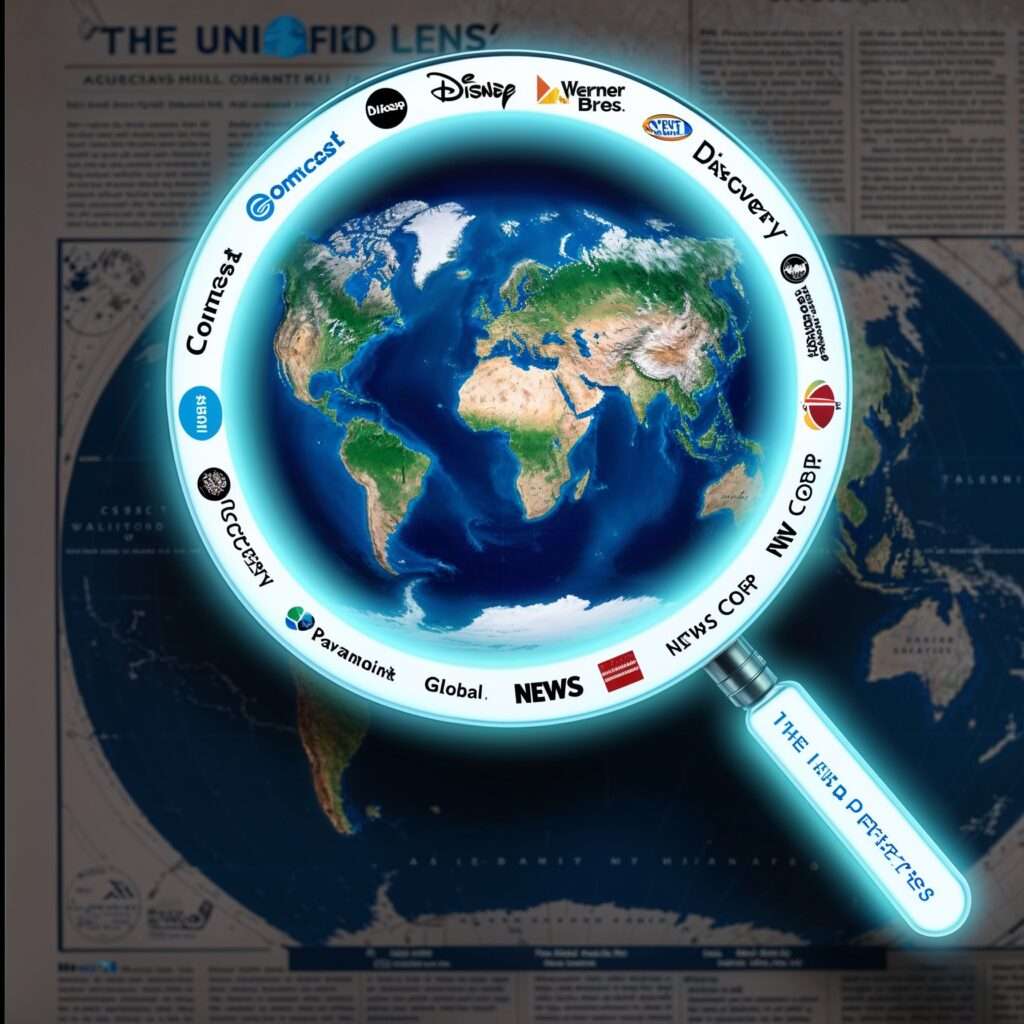
Breaking Free from Manufactured Consent
To counter the effects of this unseen alliance, media consumers must develop critical awareness:
- Question Framing: Pay attention to the language used in reporting. Ask why certain actions are glorified while others are demonized.
- Seek Diverse Perspectives: Explore independent and international news sources to uncover alternative narratives.
- Analyze Ownership: Understand who owns and funds the media you consume, as financial and political ties often shape editorial priorities.
Recognizing the Alliance Conclusion
Manufactured consent highlights the media’s dual role as both informer and influencer. By partnering with political and corporate power, mainstream outlets craft narratives that subtly mold public perception, aligning it with dominant agendas. In an age where information is a weapon, recognizing this alliance is essential for reclaiming agency over what we believe and support.
Conclusion: Unmasking the Influence
Mainstream media wields unparalleled power, shaping the perceptions and realities of billions worldwide. While it presents itself as the guardian of truth and a bastion of free press, it often operates within a framework designed to maintain control, consolidate power, and reinforce the status quo.
The Illusion of Freedom
Media’s apparent diversity masks a tightly controlled ecosystem where ownership, framing, and narrative alignment dictate what stories dominate and which are silenced. This curated reality serves powerful interests, subtly guiding public opinion and decision-making without overt coercion.
The Path to Resistance
To break free from this influence:
- Cultivate Critical Thinking: Always question the “why” behind a story and analyze its framing.
- Seek Diverse Perspectives: Look beyond mainstream outlets to independent and international sources for alternative viewpoints.
- Challenge Narratives: Pay attention not just to what is said but to what is omitted, understanding that omissions can be as manipulative as inclusions.
The Power of the Unspoken
In the end, the true power of media lies not just in the narratives it tells, but in the silence surrounding stories it chooses to ignore. Understanding this dynamic is the first step toward reclaiming control over what we accept as reality.
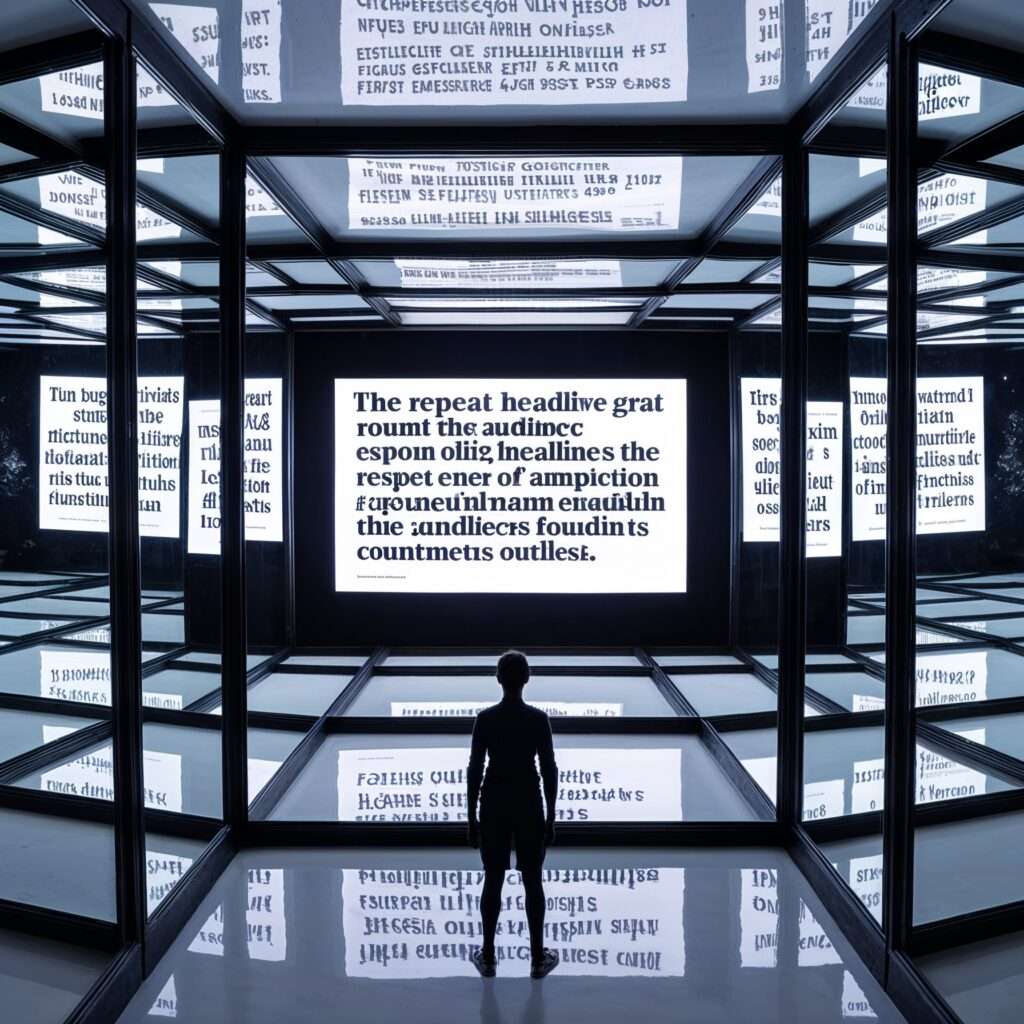
DARWIN’s Take
Mainstream media influence is not an accidental byproduct of modern journalism; it is an intentional exercise of power. Through selective storytelling, curated expertise, and algorithmic reinforcement, the media shapes not only what we believe but how we see the world.
Each headline is a thread in a larger narrative, designed to guide public perception toward a desired conclusion. As we consume these stories, we must ask: are we truly informed, or are we participants in a carefully orchestrated performance?
In this dance of shadows, the puppeteer remains unseen, yet their presence is felt in every story told. To question the narrative is to glimpse beyond the veil—to see the script for what it truly is. Only then can we begin to reclaim our understanding of truth.

Further Reading on Paranoid Prophet
- Family Feud Survey Curation Analyze the fascinating process of survey creation in Family Feud and its role in shaping the game and audience engagement.
- Mainstream News Influence Explore how curated media shapes public perception and reinforces societal norms.
- Conspiracy: Unveiling Hidden Agendas Delve into a broad range of conspiracies and uncover the subtle ways information is controlled.
Sources
To provide a comprehensive understanding of mainstream media influence, here are several insightful articles accompanied by brief descriptions:
- “More Americans now see news media gaining influence than in 2020”
This Pew Research Center article examines the shifting perceptions of media influence among Americans, highlighting an increase in the belief that news organizations are gaining power. Pew Research Center - “Study of headlines shows media bias is growing”
Researchers from the University of Rochester analyze 1.8 million news headlines, revealing a trend of increasing polarization in media coverage of domestic politics and social issues. University of Rochester - “How Does Media Influence Social Norms? Experimental Evidence on the Role of Common Knowledge”
This study explores the mechanisms through which media shapes social norms, distinguishing between individual and social effects of media influence. Cambridge University Press - “The Rise of Social Media and its Impact on Mainstream Journalism”
This report discusses how social media platforms have transformed journalism, affecting news dissemination and consumption patterns. Reuters Institute - “On the nature of real and perceived bias in the mainstream media”
This research delves into the existence and perception of bias within mainstream media, analyzing how political and socio-economic viewpoints influence news coverage. PLOS Journals
FAQ: Mainstream Media Influence
Understanding Media Influence
1. What is mainstream media influence?
Mainstream media influence refers to the ability of large news organizations to shape public opinion, set societal narratives, and steer perspectives on key issues. These organizations often determine what stories are told and how they are framed, ultimately impacting how audiences perceive the world.
2. How does mainstream media shape public perception?
Mainstream media shapes public perception through selective reporting, where certain events are emphasized while others are ignored. Additionally, the use of framing techniques and expert commentary aligned with specific agendas guides how the audience interprets events and issues.
3. Is mainstream media biased?
Yes, all media carries some level of bias. Bias often stems from factors such as ownership, political affiliations, or financial incentives. Understanding these influences helps audiences critically assess the narratives being presented.
Recognizing and Mitigating Media Manipulation
4. How can I identify media manipulation?
To spot media manipulation:
- Pay attention to sensationalized headlines that prioritize emotion over fact.
- Look for limited or one-sided sourcing in articles.
- Compare reports across multiple outlets to identify discrepancies or omissions in coverage.
5. What is the role of independent media in countering mainstream narratives?
Independent media provides alternative viewpoints and challenges the dominant narratives often perpetuated by large media organizations. By highlighting underreported stories and offering diverse perspectives, independent outlets help create a more balanced understanding of complex issues.
6. How can media literacy reduce the impact of mainstream media influence?
Media literacy equips individuals with the tools to:
- Critically analyze news sources for credibility and bias.
- Understand framing techniques used to manipulate narratives.
- Make informed decisions based on evidence rather than emotional appeals.
7. Why does mainstream media rely on sensationalism?
Mainstream media often relies on sensationalism to attract viewers and boost engagement. By crafting emotionally charged headlines and stories, they can increase advertising revenue and reinforce their financial viability, often at the expense of nuanced, fact-based reporting.
The Future of Media Influence
8. Is social media replacing mainstream media as the dominant influence?
Social media is not replacing mainstream media but amplifying its reach. Platforms like Facebook, Twitter, and YouTube often promote content from established outlets while also serving as a space for independent voices. However, this dynamic introduces new challenges, such as the spread of misinformation and algorithmic biases favoring certain narratives.
9. What steps can society take to reduce harmful media influence?
Society can mitigate harmful media influence by:
- Promoting media literacy education to empower critical thinking.
- Supporting transparency in journalism to ensure accountability.
- Encouraging diverse media ownership to reduce the concentration of narratives under a few powerful entities.
10. Can mainstream media influence ever be unbiased?
True neutrality in media is challenging to achieve, as bias is inherent in all human communication. However, fostering balanced reporting, transparency, and accountability can minimize overt biases and help audiences trust the information they consume.
11. How do algorithms amplify mainstream media influence?
Algorithms on platforms like YouTube and Facebook prioritize content that drives engagement, often favoring stories from established media outlets. This amplifies mainstream narratives, creates echo chambers, and makes it harder for alternative perspectives to reach audiences.
12. Can individuals counter media influence effectively?
Yes, individuals can take steps to reduce the impact of media influence by:
- Actively seeking diverse perspectives.
- Fact-checking information before accepting it as truth.
- Avoiding over-reliance on a single news source for information.


